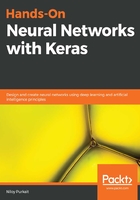
Processing signals
There may only be four fundamental forces in our universe, but they are all signals. By signal, we mean any kind of feature representations we may have of a real-world phenomenon. Our visual world, for example, is full of signals that indicate motion, color, and shapes. These are very dynamic signals, and it is a miracle that biology is able to process these stimuli so accurately, even if we do say so ourselves. Of course, in the grander scheme of things, realizing that nature has had hundreds of millions of years to perfect this recipe may humble us, if only a little. For now, we can admire the marvel that is the human visual cortex, which is equipped with 140 million densely interconnected neurons. In fact, an entire series of layers (V1 – V5) exist through which information propagates as we engage in progressively more complex image processing tasks. The eye itself, using rods and cones to detect different patterns of light intensity and colors, does an excellent job of piecing together electromagnetic radiation and converting it into electrical impulses through photo transduction.
When we look at an image, our visual cortex is actually interpreting the specific configuration of electromagnetic signals that the eye is converting into electrical signals and feeding it. When we listen to music, our eardrum, or myringa, simply converts and amplifies a successive pattern of vibrational signals so that our auditory cortex may process it. Indeed, it appears that the neural mechanisms in the brain are extremely efficient at abstracting and representing patterns that are present in different real-world signals. In fact, neuroscientists have even found that some mammalian brains have the capacity to be rewired in a manner that permits different cortices to process types of data that they were originally never intended to encounter. Most notably, scientists found that rewiring the auditory cortex of ferrets allowed these creatures to process visual signals from the auditory regions of the brain, allowing them to see using very different neurons that they previously employed for the task of audition. Many scientists cite such studies to put forth the case that the brain may be using a master algorithm, which is capable of handling any form of data, and turning it into efficient representations of the world around it.
As intriguing as this is, it naturally raises a thousand more questions about neural learning than it answers, and we sadly do not have the scope to address all of them in this book. Suffice it to say, whatever algorithm—or sets of algorithms—that lets our brain achieve such efficient representations of the world around us, are naturally of great interest to neurologists, deep learning engineers, and the rest of the scientific community alike.